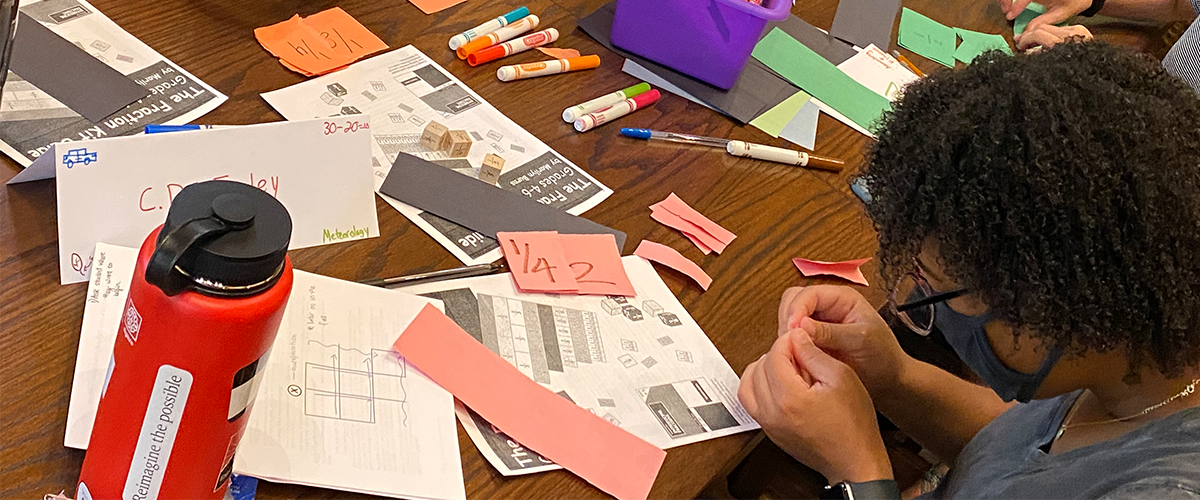
JRCoE Launches Transformative Tutoring Initiative
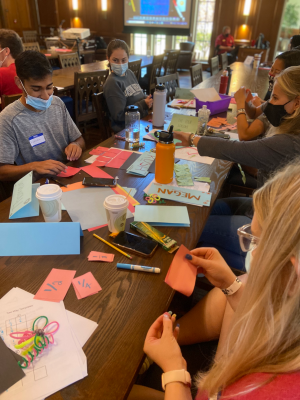
A new project in the Jeannine Rainbolt College of Education this fall is the Transformative Tutoring Initiative. Approximately 60 OU students are tutoring Algebra I students at Santa Fe South High School and Noble High School as part of a two-year program using high-dosage tutoring through a $2.93 million gift to the OU Foundation from Randall and Lenise Stephenson of Dallas.
OU’s Director of Community Engagement Joy Pendley had been leading conversations across campus about creating a tutoring corps that would work across multiple colleges to help with COVID learning loss. At the same time, the Stephensons approached the university with the idea of funding a tutoring program.
“It was a perfect alignment of conversation that was already underway and the hopes of a donor to fund this kind of project,” said Stacy Reeder, dean of the Jeannine Rainbolt College of Education. “Through those discussions, we decided to focus on a high-dosage tutoring model.”
High-dosage tutoring is three to five days per week of 45 minutes to an hour of tutoring with a ratio of one tutor to two students. This has been studied in other states and at other universities, showing tremendous promise for helping students make academic gains. Research has shown being successful or unsuccessful in mathematics at the high school level is one of the leading factors to students dropping out or not graduating. Additionally, mathematics is one of the hardest areas to catch up in when students fall behind.
“This isn’t just homework help,” Reeder said. “It isn’t the tutors coming in and deciding what they want to work on. We assess the students where they are; we are in conversation with the teachers, so what we are doing in tutoring aligns with what the students need to be working on.”
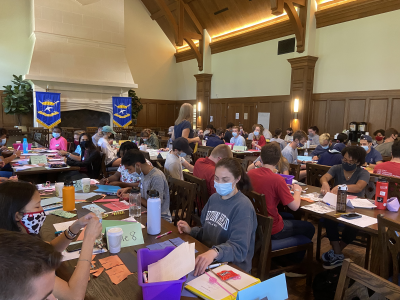
“The Stephenson family is amazing,” said Cristina Moershel, director of the program. “They meet with us regularly, have met a couple of the tutors and are really interested in the data coming from the project. They are very interested in education in Oklahoma and want good outcomes for students.”
To read more about the Stephensons' involvement in the program, visit
https://www.oufoundation.org/impact/Story/731
The research team is led by Assistant Professor Daniel Hamlin, along with Assistant Professor Corey Peltier, Assistant Professor Kate Raymond and post-doctoral researcher Jennifer Johnson. They will look at several components in gauging the success of the program. Not only will they be looking at test scores and grades, but will also account for things like attendance and behavior to see if relationships built with the tutoring will encourage students to come to school and work harder to be successful.
“For the quantitative analysis, we will be comparing a treatment and control group, looking at their math scores, grades and eventually their graduation rates,” Hamlin said. “We will also be doing some engagement surveys, looking at their attendance and disciplinary measures as well.”
“Our goal for this project over the two years is two-fold,” Reeder said. “First is to develop the best tutoring program we can with our school partners. Second, to study the impact of the tutoring program on student learning outcomes. We want to know at the end of two years what a high-dosage tutoring program might look like for Oklahoma schools, with the hope it can be scaled up to include a larger number of students across the state.”
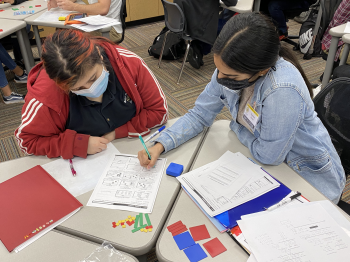
Moershel was hired as director of the program in July and had just a few weeks, along with team leader Mandy Howell, to get the students hired, trained and ready to go into the classrooms. Almost 200 students were interviewed via Zoom to narrow down the 60 selected to participate. The tutors come from majors across the OU campus and are compensated with a $3,000 scholarship and $3,000 stipend each semester. There is a weekly commitment of six to eight hours per week, inclusive of tutoring and training.
The tutors first had to go through training similar to teacher training to learn rules and regulations involved in working with high school students. They also did an online training from Saga Education, a leader in training highly effective tutors that focused on good strategies, diversity and inclusion and how to build positive relationships with the students.
That was followed by a weekend of mathematics training led by Reeder, who is a mathematics educator, where they learned warmups and ways to teach fraction skills.
“After going through that training, a lot of the students said ‘Wow, I wish I would have had someone teach me fractions this way when I was in school,’” Moershel said. “Not only did they learn something new, but they were having fun doing it.”
“This experience has been eye-opening,” said Manuvel Sibichan, a freshman double majoring in finance and accounting in the Price College of Business. “Through being a tutor, I have had revelations time and time again about how much I overlooked my past teachers’ efforts. But in retrospect, I have gained so much more appreciation for the work all my teachers have put in. For TTI, we set weekly goals for our tutees, which I also have begun doing for myself. Additionally, through this program, I have honed my ability to simplify and explain complicated topics in more simple manners, which should be helpful later down the road.”
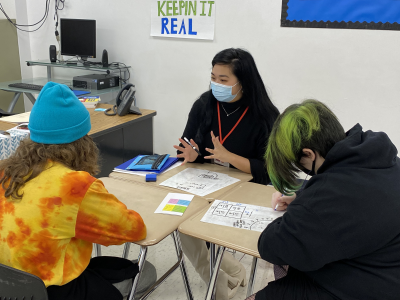
Qualitative data being collected in this program includes having the tutor and students write reflective notes each week. In this very early data collection, students are already reporting they have raised their letter grade in mathematics. The tutors are reporting on the relationship they are building with their students.
“This has been something that has been neat to watch unfold,” Johnson said. “You can tell from these reflections that when the tutors go home, they are thinking about how to refine the process for the students they are teaching. A lot will go home and research different strategies to help teach the content. It has been great to read about these growing relationships.”
Moershel (Santa Fe South) and Howell (Noble) are at the schools each week to observe the tutoring sessions and are seeing the impact up close.
“They are all engaged,” Moershel said. “Rarely do I see a student who is unwilling to participate because they are doing a lot of hands-on activities. We aren’t just doing worksheets. The students also get to make up problems for each other and even though they are high school students, they get stickers as rewards, which they love.
“The teachers are also really happy with it. They like the strategies the tutors are using and plan to use them with their own classes because they see it can actually work. At one school after the first week, the teachers couldn’t believe what they were seeing with all the students participating and talking about the mathematics concepts. It was just because we switched it to being fun. It’s not about sitting down and memorizing facts; it’s let’s make models and talk about what we are doing.”
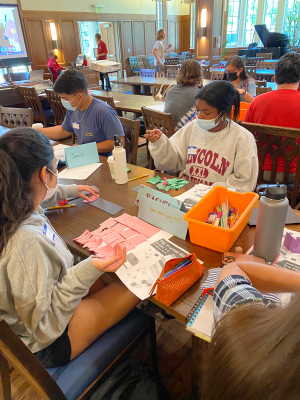
“This program has brought me a lot of fulfillment,” Sibichan said. “I can see that I make a difference in their lives, which consequently makes my days much better. The most enjoyable part of the program for me is seeing my tutees grow their knowledge in math and love for learning. One of my tutees even said they saw me as an older brother, which caught me off guard, but I would have to agree it is spot on. The tutors double as their mentors and tutors, and an older sibling is a great way to encompass it.”
The hope after year one is to see a greater improvement in the students’ assessment scores in relation to their peers. With continued support from donors beyond the two years, the goal would be to partner with other colleges in the state to expand this program into other schools.
“Every state, especially Oklahoma, is in need of this kind of help in its schools,” Moershel said. “We hope to create a guidebook that if a university wants to do this for their neighboring districts, we can show them this is what we did, this is what we found did and didn’t work, and we did this in urban and suburban districts so you can replicate it to your needs.”
